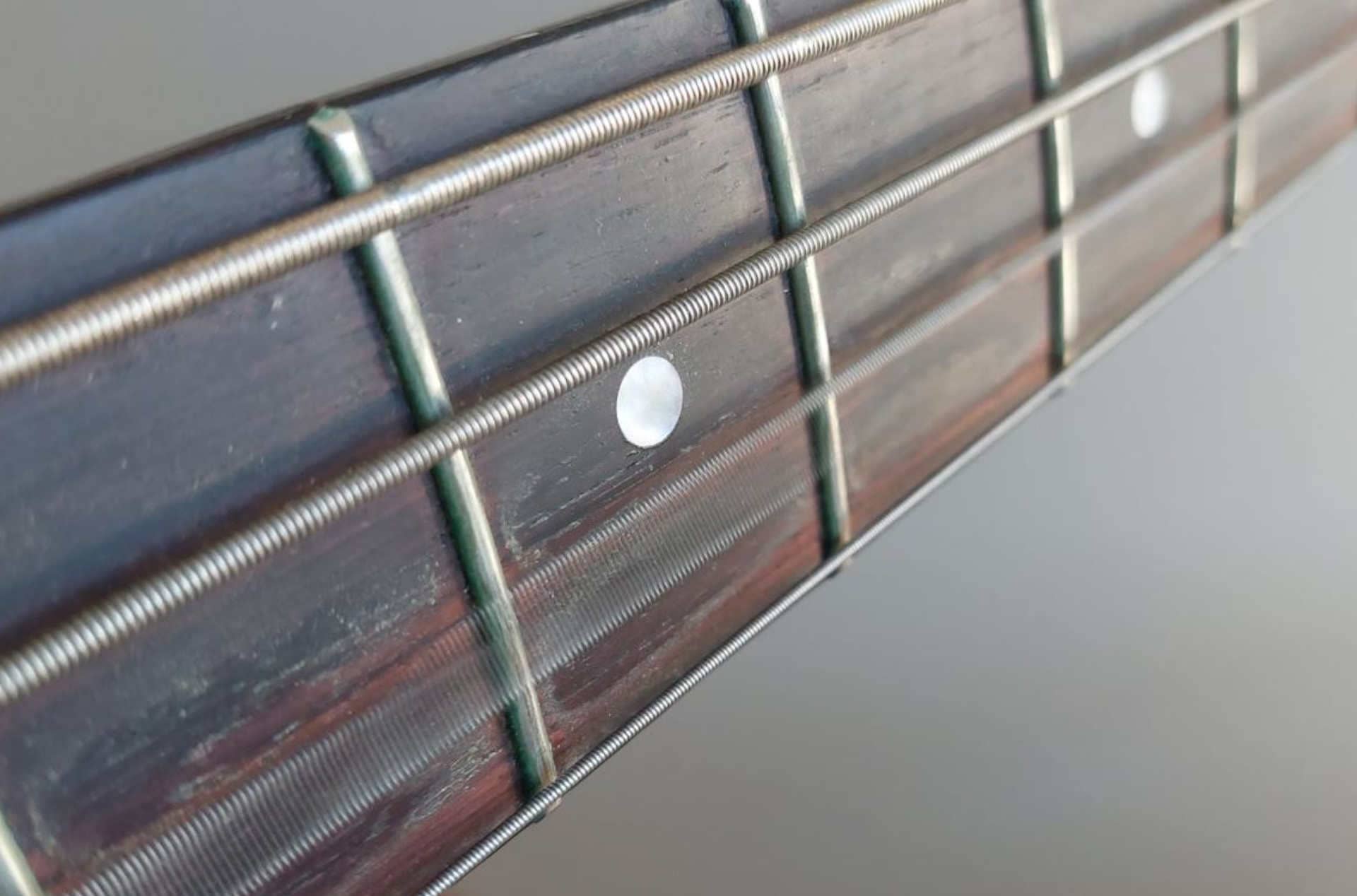When playing the bass, damping and muting have a major impact on your overall tone. Damping can not only make or break your sound but also set the overall mood of a song. As the term is used in various ways, let’s start off with the obvious question: What is damping on the bass?
On the bass, damping refers to various ways of muting strings in order for them to not ring out or to produce a muskier sound. Both the left and right hand can be used to dampen bass strings. It can also be done with the help of external gear such as a fret wrap or a sponge.
To make damping strings easy for you, I`m going to cover all the various ways to dampen your bass in this article.
I`ll start off by listing all the ways in which you can mute the strings on your bass. Then I`ll cover both right and left-hand techniques, and how you can use both to keep strings muffled or muted.
Lastly, I`ll show you the various materials and tools you can use to provide permanent damping to your bass. This way, you can choose an option that suits your needs, and you won`t have to waste your time on a damping solution that won`t result in the type of sound you are looking for.
How do you dampen bass strings?
There are two main ways of damping bass strings. Through your playing technique, or by adding a damper to your bass. The following are the most common ways of keeping strings damped:
- Playing lighter
- Muting strings with proper left and right-hand technique
- Adding a piece of foam underneath the bridge
- Using a fret wrap
- Using lighter strings
- Playing with flatwound strings
- Damping the bass strings with a piece of cloth
Using your hands to keep strings from ringing out is one of several necessary steps for getting a clean bass tone. This can be done by using the fingers on your fretting hand to rest on unplayed strings in order to keep them muffled.
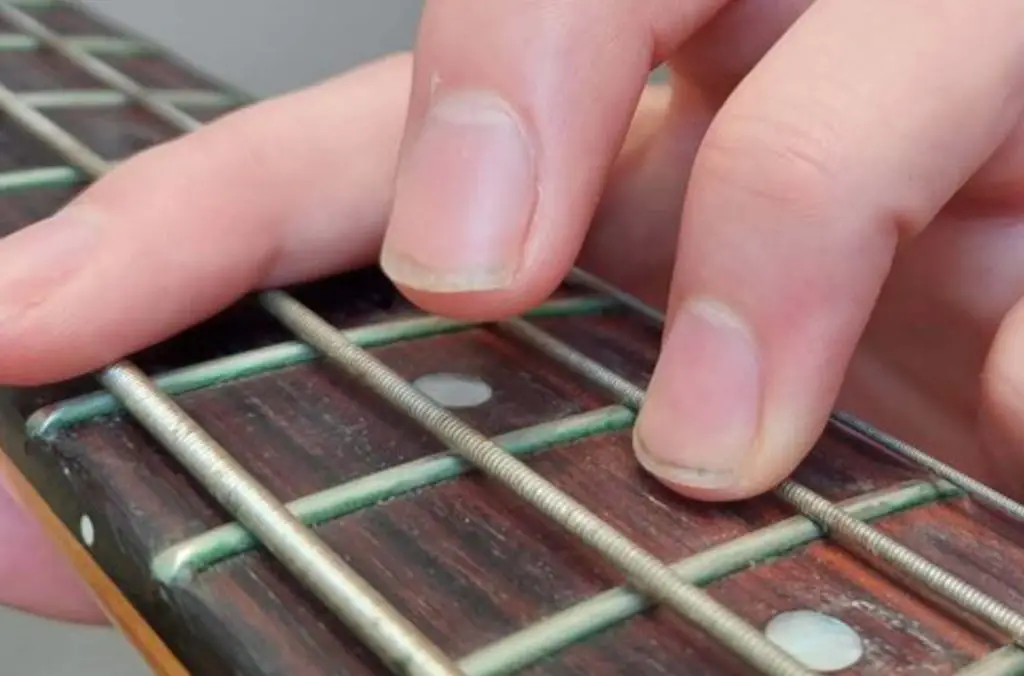
Your plucking hand should also rest against unplayed strings. Fingerstyle players can do this by placing their thumb against the deepest unplayed string. This is commonly done in one of two main ways.
The first of these is with a floating thumb. This is when the thumb is kept loose and touches the string lightly. This way it is able to keep strings muted, without having to be anchored to them.
The second way is with a movable anchor. This is when the thumb rests on top of the deepest unplayed string and thus prevents it from having a chance of ringing out:
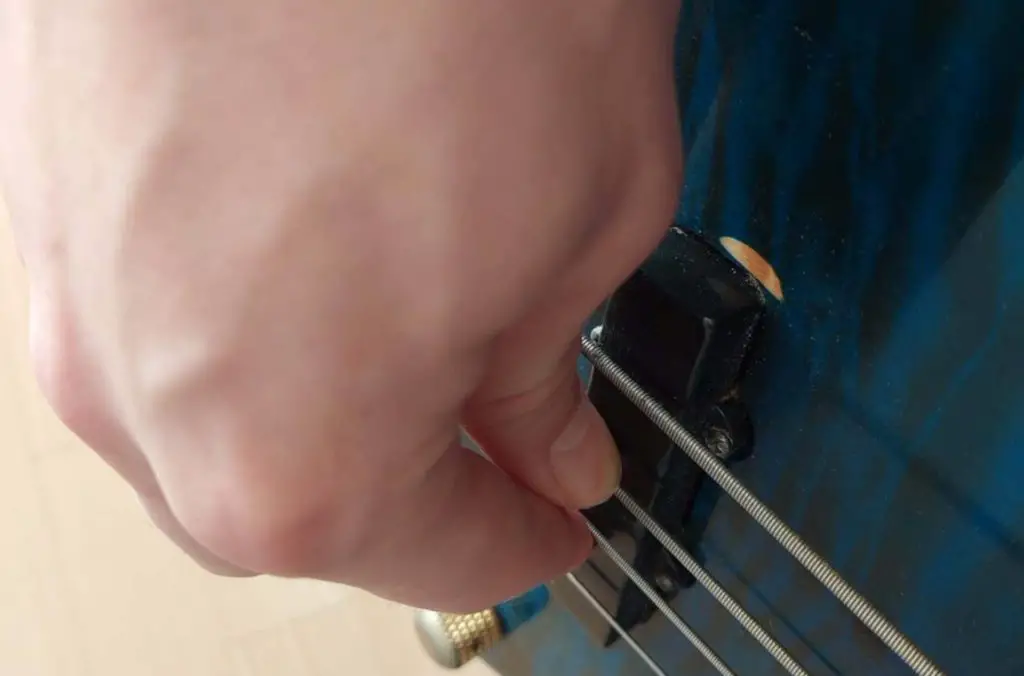
If you play with a pick you can use the palm of your hand or your ring or little finger to keep the strings damped. You also have the option of making your tone even more damped by palm muting the strings.
Regardless of playstyle, another important factor is how hard your pluck the strings. Lighter plucking will have a similar effect to damping the strings. This is because the strings will resonate less when plucked lightly.
Thus, I recommend trying to pluck strings with less force. The upside of this is that you can always turn up the volume while retaining a more damped tone.
Fret wraps for the bass
Fret wraps are straps that are attached to the neck of your bass. They are generally used to prevent unwanted strings from ringing out, and to attain a more muffled bass tone.
I go more in-depth about their usefulness in my article on fret wraps for the bass guitar. Put shortly, fret wraps are a simple and effective way to dampen strings. Fret wraps are available for purchase online, or alternatively, you can make one of your own.
Professionally made fret wraps have the upside of being easily adjustable. They wrap around the neck of the bass and attach to themselves with velcro. Thus, wraps can be tightened or loosened, which puts you in control of how much you want to dampen your strings.
DIY fret wraps have the upside of being cheaper. I have used a rubber band that happened to fit my bass as a fret wrap. This worked well for me and provided for a slightly more muffled sound. You can also use a hairband, or attached a piece of foam with the help of a rubber band.
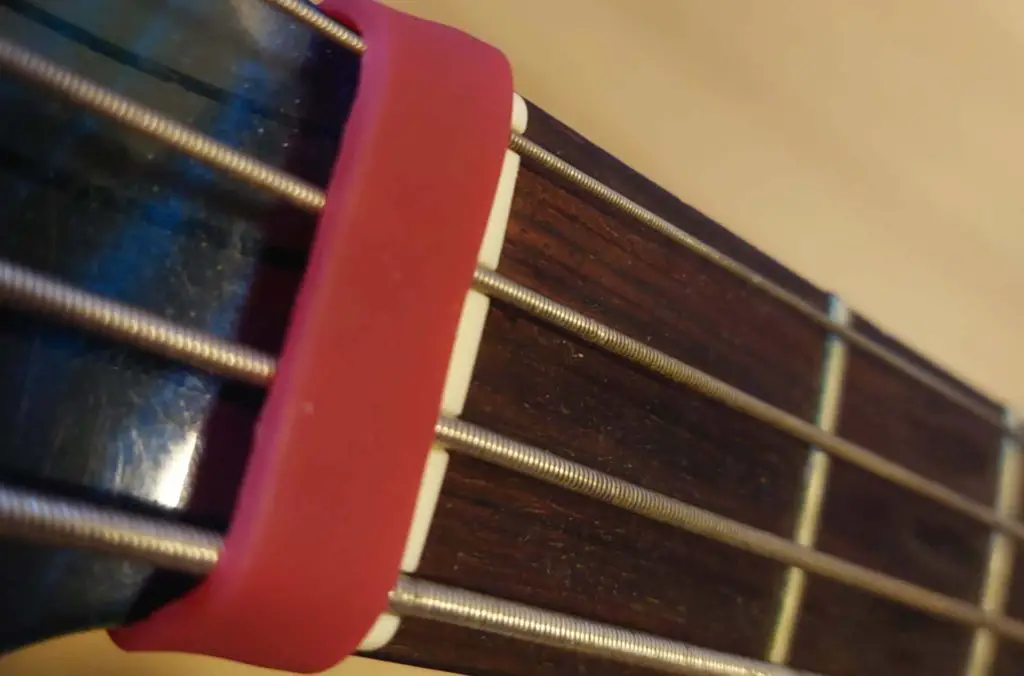
For an option that doesn`t require DIY work, Gruvgear is a company that makes fret wraps in various sizes. If you intend to purchase one, choose the small size for 4-strings, and the medium one for 5-string basses.
Using foam to mute the bass
Another option is to use a piece of foam to dampen your bass strings. This piece of foam is placed underneath the strings of your bass at the bridge.
While this can sound like a strange thing to do, it`s a trick that is as old as the electric bass itself. Early versions of the bass guitar had a piece of foam seated under the bridge cover. Legendary bassists James Jamerson and Carol Kaye are also both known for using foam to dampen their strings.
As a result, the bass strings are damped and become more resemblant to that of the double bass.
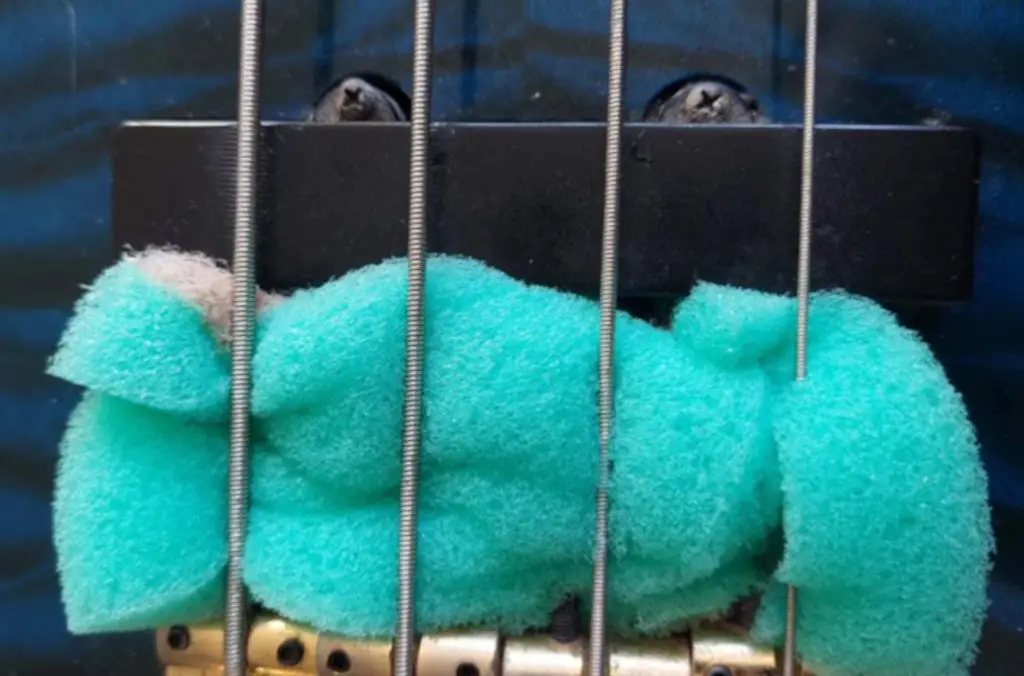
For a better result, you will generally need to cut the foam to suit your bass. This is because the strings have different gauges, and the foam will usually provide more damping on the E string than the G string.
The foam might also be too large to fit properly underneath your strings. In this case, it will need to be cut so that your strings don`t end up sounding overly muffled.
One way of doing this is to use a knife to make individual cuts in the foam that fit the strings. Another is to slice the foam across the top to make it thinner towards your lighter strings.
Depending on the foam and your knife, this can be somewhat cumbersome. Thus, choose a sharp cutting tool and foam that is easy to cut through if possible.
How do you mute a bass with a sock?
You read that correctly. As an alternative to using foam, some bassists elect to use a piece of clothing to dampen their strings with socks being a common option.
This is done the same as with a piece of foam, and the piece of clothing is attached under strings at the bridge of the bass.
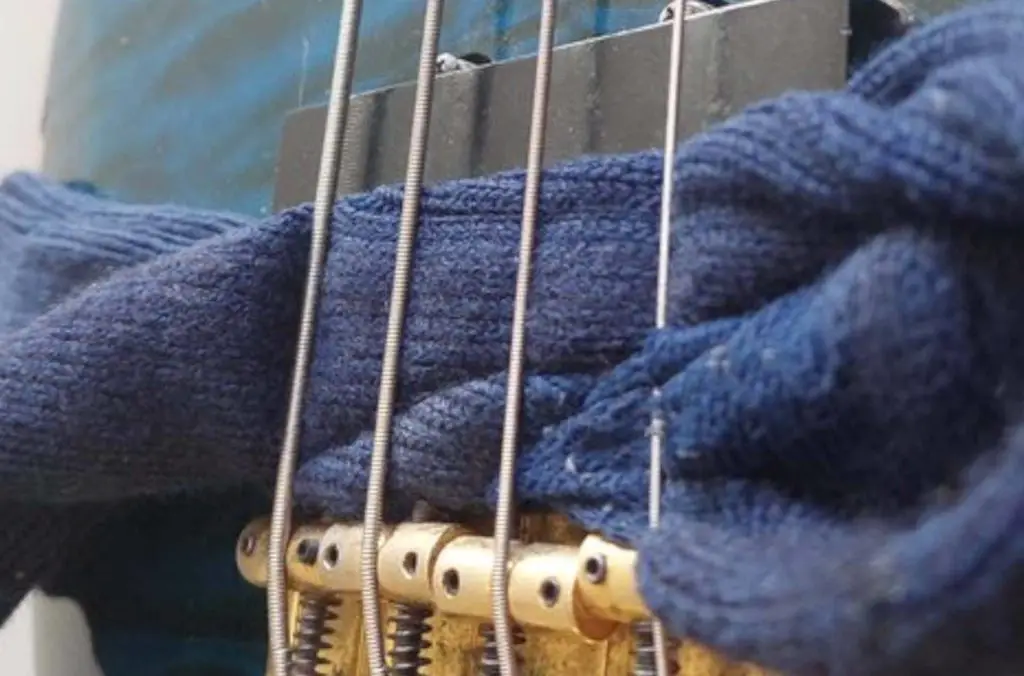
The upside to this is that most people have many pieces of clothing easily available. You don`t have to get your hands on a piece of foam and cut it into the right size. You simply put the sock or piece of clothing under your strings, and you are ready to go.
There are however two main downsides to this. The first is that it can be hard to find clothing that fits the bass well. You also can`t adjust it a whole lot. Thus, while clothing is flexible enough to fit well under the strings, you have little control over the amount of damping it provides.
The other downside is that using a sock for damping doesn`t look that great. For practice and for recording it might not matter as much. However, not all bassists are going to want a sock hanging from their bass during live shows.
I recommend using a sock or other piece of clothing if you want a convenient and simple way of damping your bass strings. It is the fastest and simplest way to efficiently dampen your strings and can thus be a preferable option in many cases.
If you are looking for more control over how much the strings are dampened and a more pleasant-looking bass, I recommend using another option.
String wounding and gauge
One last tip for a more damped sound is to use flatwound strings and a light string gauge.
Flatwound strings have a naturally muskier and darker tone than roundwounds. This makes for a tone that sounds smooth rather than lifeless when damped.
Another upside of flatwound strings is that some consider them easier to mute. This makes it easier to apply the right and left-hand muting techniques discussed above. In turn, this makes it easier to produce a cleaner bass tone.
As for string gauges, a light set of strings can be preferable to a heavy set. This is because they won`t produce as resonant and boomy of a tone as thicker strings. This makes them easier to stop from ringing out and to play with a lighter touch.
While string choice comes down to preference, I would recommend a .100-.045 gauge flatwound set for a damped bass tone. 5-string players can add a .125 string for the low B string.
Conclusion
As you can see, there are many steps you can take to dampen bass strings.
The two main to do so are to mute strings with your left and right hand, and to use an item to mute your strings. Using your hands to mute strings is an essential skill that makes for a cleaner sound. Using an item for a damped effect is done to change the tone of your instrument.
For a quick and easy way to add damping throw a sock or small piece of clothing under the strings at the bridge of the bass. In order to get more control over how much the strings get damped, purchase or make a fret wrap, or cut a piece of foam to fit the strings.
Regardless of what method you choose, they will all work for damping your strings. If you are looking for damping, chances are that you already have a good ear for bass tone. Thus, you can choose one or more of the methods listed above to get exactly the type of tone you are searching for.
For fingerstyle players, how you place your thumb will have a big impact on how well you can dampen your strings. To learn more, read my guide on thumb placement for bass players.

